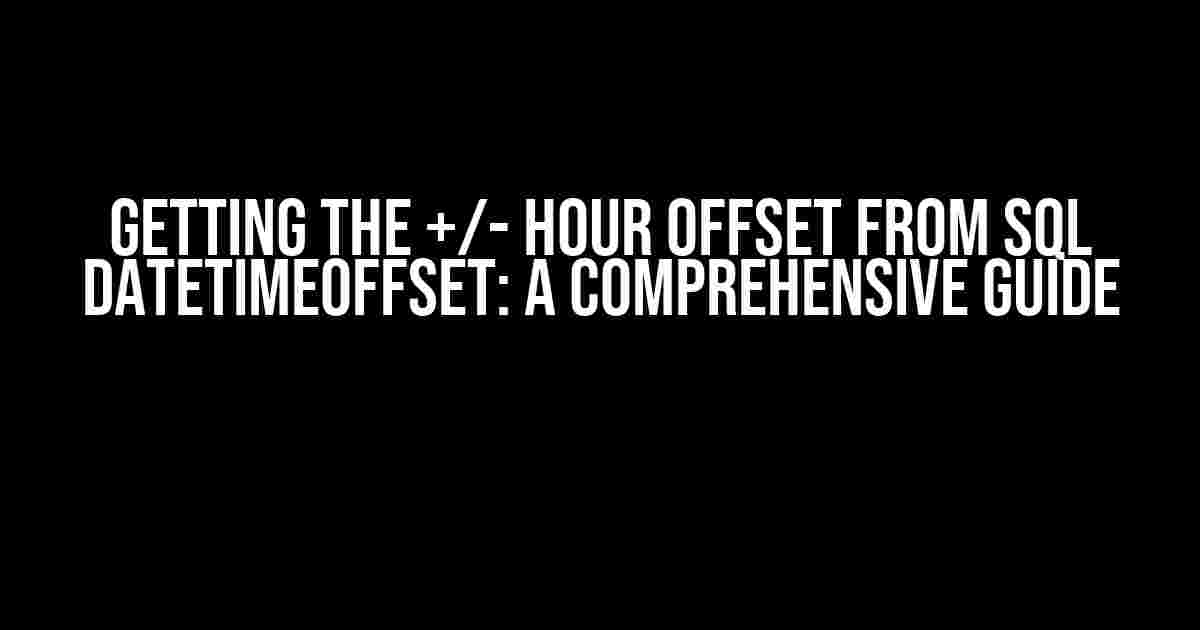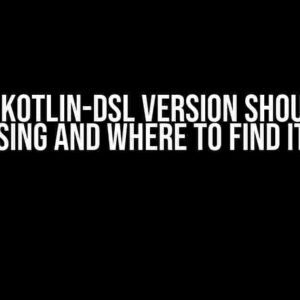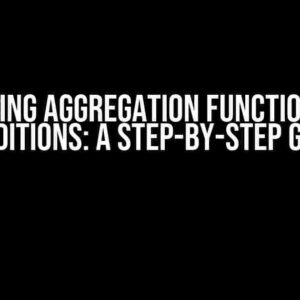As a developer, you’ve probably encountered the need to work with datetimeoffset data types in SQL. But have you ever wondered how to extract the +/- hour offset from a datetimeoffset value? Well, wonder no more! In this article, we’ll dive into the world of datetimeoffset and explore the various ways to get the +/- hour offset from SQL datetimeoffset values.
What is a datetimeoffset?
A datetimeoffset is a SQL data type that stores a date and time value, along with an offset from Coordinated Universal Time (UTC). This offset is represented as a +/- hour value, ranging from -14 to +14. The datetimeoffset data type is particularly useful when working with dates and times across different time zones.
Why do we need to extract the +/- hour offset?
Extracting the +/- hour offset from a datetimeoffset value can be useful in various scenarios, such as:
- Converting datetimeoffset values to a specific time zone
- Performing date and time calculations across different time zones
- Storing datetimeoffset values in a standardized format
Method 1: Using the TODATETIMEOFFSET function
The TODATETIMEOFFSET function is a built-in SQL function that converts a datetimeoffset value to a datetimeoffset value with the specified offset. However, we can use this function to extract the +/- hour offset by converting the datetimeoffset value to a datetimeoffset value with a zero offset, and then subtracting the original offset.
DECLARE @dto datetimeoffset = '2022-01-01 12:00:00.0000000 +08:00';
SELECT TODATETIMEOFFSET(@dto, 0) - @dto AS OffsetHours;
-- Result: 8
This method works, but it’s a bit convoluted. Let’s explore other options.
Method 2: Using the DATEPART function
The DATEPART function is another built-in SQL function that extracts a specific part of a date or datetime value. We can use this function to extract the hour component of the offset.
DECLARE @dto datetimeoffset = '2022-01-01 12:00:00.0000000 +08:00';
SELECT DATEPART(tz, @dto) AS OffsetHours;
-- Result: 8
This method is more straightforward than the previous one, but it’s still not the most elegant solution.
Method 3: Using the AT TIME ZONE function
The AT TIME ZONE function is a SQL Server 2016+ feature that allows us to convert a datetimeoffset value to a specific time zone. We can use this function to extract the +/- hour offset by converting the datetimeoffset value to the UTC time zone.
DECLARE @dto datetimeoffset = '2022-01-01 12:00:00.0000000 +08:00';
SELECT (CAST(@dto AT TIME ZONE 'UTC' AS datetimeoffset) - @dto) / 60 AS OffsetHours;
-- Result: 8
This method is more concise and efficient than the previous two methods.
Method 4: Using string manipulation
We can also extract the +/- hour offset using string manipulation techniques. This method involves converting the datetimeoffset value to a string, extracting the offset component, and then converting it back to an integer.
DECLARE @dto datetimeoffset = '2022-01-01 12:00:00.0000000 +08:00';
SELECT CONVERT(int, RIGHT(CONVERT(varchar, @dto, 120), 6)) / 60 AS OffsetHours;
-- Result: 8
This method is less elegant than the previous ones, but it works.
Comparison of methods
Let’s compare the performance and readability of the four methods:
| Method | Performance | Readability |
|---|---|---|
| TODATETIMEOFFSET function | Medium | Low |
| DATEPART function | High | Medium |
| AT TIME ZONE function | High | High |
| String manipulation | Low | Low |
Apart from the string manipulation method, the other three methods have similar performance characteristics. However, the AT TIME ZONE function method is the most readable and concise.
Conclusion
In this article, we’ve explored four methods for extracting the +/- hour offset from a SQL datetimeoffset value. While each method has its pros and cons, the AT TIME ZONE function method is the most efficient and readable solution. Whether you’re working with datetimeoffset values in SQL Server, Azure SQL Database, or another database management system, this article has provided you with the knowledge and tools to tackle datetimeoffset-related challenges.
Remember, when working with datetimeoffset values, it’s essential to consider the offset component to ensure accurate date and time calculations. By extracting the +/- hour offset, you can perform more precise conversions and calculations, and ultimately provide better results for your applications and users.
Happy coding!
Frequently Asked Question
Are you struggling to get the +/- hour offset from a SQL datetimeoffset? Don’t worry, we’ve got you covered!
How do I extract the hour offset from a datetimeoffset in SQL?
You can use the `TOTALSECONDS` function to extract the hour offset. For example: `SELECT TO_TZOFFSETFROMPARTS(TOTALSECONDS(date_time))/3600 AS hour_offset FROM table_name;`
What is the purpose of the TO_TZOFFSETFROMPARTS function in SQL?
The TO_TZOFFSETFROMPARTS function is used to convert a total number of seconds to a time zone offset, which is represented as a string in the format ‘+/- HH:MM’.
How do I handle daylight saving time (DST) when working with datetimeoffset in SQL?
To handle DST, you can use the `AT TIME ZONE` function in SQL, which takes into account the DST rules for the specified time zone. For example: `SELECT date_time AT TIME ZONE ‘Pacific/Auckland’ AS dst_aware_datetime FROM table_name;`
Can I use the datetimeoffset data type to store UTC timestamps in SQL?
Yes, you can use the datetimeoffset data type to store UTC timestamps, but you need to specify the UTC time zone explicitly. For example: `SELECT SYSDATETIMEOFFSET() AT TIME ZONE ‘UTC’ AS utc_timestamp FROM table_name;`
Are there any performance considerations when working with datetimeoffset in SQL?
Yes, working with datetimeoffset can be slower than working with other datetime data types, especially when performing calculations or conversions. It’s essential to optimize your queries and indexes to minimize performance impact.




